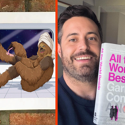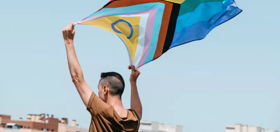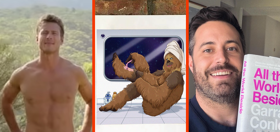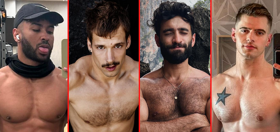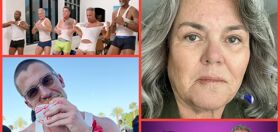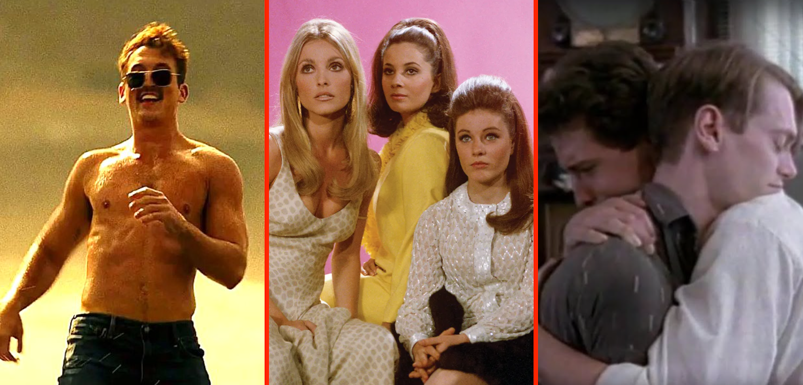
In this exclusive excerpt from his new memoir, Movies That Made Me Gay, out now, landmark American writer and queer black icon Larry Duplechan celebrates the power of cinema in shaping queer identity.
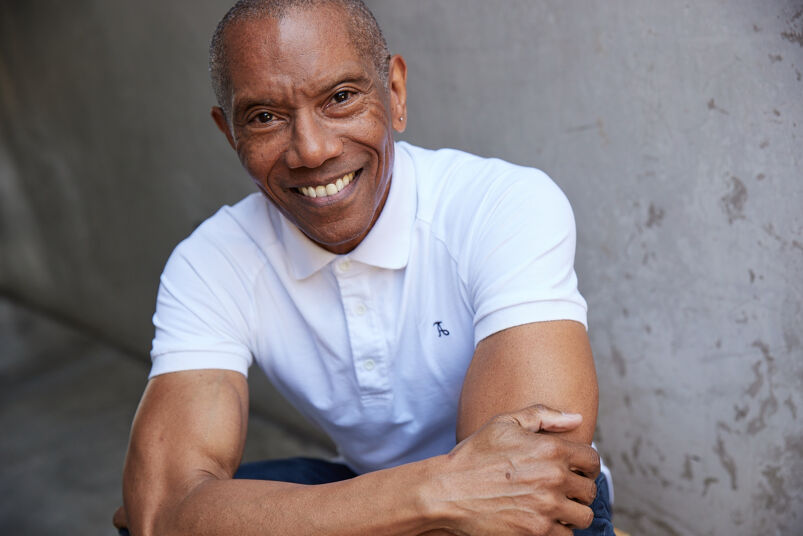
My very first published piece was a little memoir about the handsome young actors I watched on TV (and vaguely crushed on) as a child – Tony Dow, Billy Gray and Johnny Crawford, among them – entitled “Good Night, Rick Nelson, Wherever You Are”. It was published in 1983, in the beefcake magazine In Touch For Men, between an interview with John James (the handsome young actor then playing “Jeff Colby” on the ABC nighttime soap opera, Dynasty), and four pages of candid photos of surfers flashing bare booty as they changed into and out of their wetsuits. And through the remainder of the 1980s and into the ’90s, again while I was writing those little novels, I was asked to write the occasional book review (Christopher Street magazine) or pop music essay (In Style For Men magazine); but neither my idol Vito Russo (author of the seminal work on gays in the movies, The Celluloid Closet (1981) – more on that book, and Vito, later) nor David Ehrenstein (Open Secret: Gay Hollywood 1927-1997 (1998)) were fearing for their jobs.
With the advent of social media, wherein everyone (literally, everyone) is a critic, I found an outlet for my desire to write about pop music, television, and movies – especially movies – on Facebook. Since 2008, I have spent what many might consider an inordinate amount of time on Facebook; posting photos of things that catch my eye on my daily morning walks with my husband through our suburban Los Angeles neighborhood; photos of our Chartreux cat, Mr. Blue (who has over the years gathered a social media following of his own); post-workout shirtless selfies; and brief essays about pop culture – again, especially movies. Mostly old movies, “classic” and otherwise, from the advent of the Sound Era through the 1970s (movies I have loved since childhood), but not exclusively: the vigorous and borderline-contentious string of comments to my post on Top Gun: Maverick (2022) – I made the grievous error of admitting I had enjoyed it – prompted a month-long moratorium from social media in February of 2023.
It was on Facebook, and because of Facebook, that I adopted the motto, I Never Argue Taste. Now, I can be pretty insistent about facts: Oliver! (1968) won the Best Picture Oscar in 1969, beating out Funny Girl, Zeffirelli’s Romeo and Juliet, and The Lion in Winter. That’s a fact. I think Lion should have won, but that’s my opinion. If you think Oliver! is a better film than The Lion in Winter… well, I might well roll my eyes, but I won’t argue the point. I never argue taste. Also, some of my favorite movies are bad movies. Oh, I don’t mean flawed movies, I mean Truly Bad Movies – yes, in initial caps: I consider Truly Bad Movies to be a genre, like Film Noir. For example: I have watched Valley of the Dolls (1967) countless times. And I always enjoy it. I talk back to it, I quote from it, I wrote about it in this book. And yes, I realize and acknowledge that Valley of the Dolls is crap: an utterly misbegotten collection of “What were they thinking?!?” moments, basted together with verses of a rambling, meaningless song. A Truly Bad Movie. So if you make it a practice not to watch bad movies, much less watch one many times, I have to respect that. Because that’s an issue of personal taste. And I never argue taste. Alas, so many people do. (Especially on Facebook.)
Okay, let’s talk about “Pride”, Pride festivals, Pride parades, and Pride Month.
I am neither proud nor ashamed of being gay. It just is. I’m proud of my Lambda Literary Award, and my pecs, which I consider to be actual accomplishments; I’m proud of queer folk who march through the streets of Moscow. Marching through West Hollywood isn’t nearly as significant or impressive. In my observation, most “Pride festivals” are overly-commercialized beer parties – and mind you, I like a good party as much as the next old gay dude. But in most years, in most American cities, the annual Gay Party has bugger-all to do with gay history (I dare you to ask random attendees what happened at Stonewall and when), is about as politically relevant as the Renaissance Faire, and tends to marginalize or ignore POCs and women, shoving them onto a sofa against the wall, like math geeks at a frat mixer. If Pride actually had a dad-gum thing to do with “gay pride”, there would be staged readings from Walt Whitman, and a Bayard Rustin float.
By way of a “Five Miles Through The Snow” story: I came out in 1974 – five years after Stonewall. The American Psychiatric Association had resolved that homosexuality was not a mental illness just one year earlier. One. Year. Granted, I’m a geezer, but it really wasn’t that long ago. So yes, I think it’s important for queers to know, remember and acknowledge that Pride exists because in June 1969, a bunch of Greenwich Village street kids and drag queens finally decided to say “Hell No!” to police raids on gay bars – the only places queer folk could gather to socialize; Hell No to the fact that same-sex dancing was an arrestable offense; Hell No to being criminals just for being.
And what queer history does get memed and posted around Pride is often factually questionable agitprop, promoted by tiny subsets of the queer community far more interested in grinding their axes than in actual history.
Case in point: The “transwomen of color started the riots” myth. Sorry, but it just doesn’t hold up. The two individuals (and I use that term deliberately, because they both self-identified, at different times, as gay men, transvestites, drag queens and, yes, transwomen) most often served up as Brick-Thrower-Zero are Marsha P. Johnson and Sylvia Rivera. Marsha said herself (there’s an audio recording) that she didn’t even arrive at the Stonewall the first night until the riot was well underway; and it’s unclear whether Sylvia ever showed up at all. Both were very active in the Gay Liberation Movement that followed in the wake of the riots, and can be seen in many photos of the first Gay Pride Parade in 1970. But again: Marsha P. Johnson did not “throw the first brick”. And I know: this hasn’t a thing to do with movies. But I am sufficiently weary of this particular canard that I had to get it off my chest.
And no, I am not some sort of Pride Grinch. I’m not trying to tell you not to go to Pride. You like Pride – have at it. Me, I’d rather re-read David Carter’s exhaustive history, Stonewall: The Riots That Sparked a Gay Revolution (2010), and watch a stack of gay-themed movies on DVD. Otherwise known as Larry’s Pride Month Film Festival.
The preceding “Hey, you kids, get off my lawn” rhetoric notwithstanding, I’m the first to admit that I am not a particularly deep person. Certainly not when it comes to movies. I mean, you’ve read this far, so you know I love a wisecrack, a kick line, a cute spunky girl puttin’ the song over, a dude dancer in sailor whites. Oh, I’ve seen The Grapes of Wrath and The Diary of Anne Frank – I have also read the books. But I have yet to attempt Schindler’s List, and as previously reported, I couldn’t get through 12 Years a Slave. My favorite movies, the ones I come back to year after year (or even more than once in any given year), are fun movies. As my literary alter ego and mouthpiece, Johnnie Ray Rousseau opined in my second novel, Blackbird (1986), a movie is something you go see to have a good time. As demonstrated in the February section, I am far more likely to celebrate Black History Month by watching Car Wash for the eleventy-seventh time, than (say) John Singleton’s brilliant but emotionally harrowing Rosewood (1997), which I have seen – one time – and very much admire.
Similarly, my Pride month film festivals tend to skew toward comedy, romance, and romantic comedy – again, fun. Of course, there are exceptions: The Mart Crowley Troika (both versions of The Boys in the Band, followed by the Making the Boys documentary) was part of my 2022 Pride month fest. But overall, in any given June, I’m a good deal more likely to screen Billy’s Hollywood Screen Kiss (1998, Tommy O’Haver, dir.) – Sean Hayes, just pre-Will & Grace, and an astounding 12 years before coming out publicly, stars as an amateur art photographer crushing on a sexually vague buddy, played by Brad Pitt impersonator Brad Rowe – than, say, Parting Glances (1986, Bill Sherwood), one of the first films to feature a gay male character living with AIDS. Oh, I saw Parting Glances, in a movie theater in 1986, cried myself into a sore throat, and never saw it again. Which pretty well describes my relationship with the entire Gay Men With AIDS sub-genre.
Forgive me, but I just don’t need to watch movies about AIDS. I was there. Our best friend William Edward “Wef” Fleischman died in December 1989, at 32 years old – the first friend we lost to AIDS, but far from the last. College friends and the friends of my twenties sickened and died through the 1990s, when AIDS drugs finally began saving more lives than they ended. I dedicated my 1991 novel, Captain Swing, to some of them: classical pianist David Sebulski, pop singer Mark Yetter, jazz crooner Don Fusco, painter/writer Alan Cumbey, who initiated our friendship with a fan letter, and who was slightly miffed at me for admitting that I preferred his one-panel line-art cartoons to his serious oil paintings. Gary Steele, who taught UCLA’s first Gay Studies course in 1977. Steve Witner, whom I knew from the UCLA Men’s Glee Club, who came to our home for a party one evening in the early 1990s, having lost so much weight in so short a time that I didn’t recognize him – I mean, I thought he was a stranger – who gamely announced he was determined to “hang on long enough for the cure”, and who died within the year. Danny Matson from… somewhere in Alabama, he of the Bette Davis eyes and Cherokee cheekbones, and a velvety first-tenor singing voice that he lost when Kaposi’s Sarcoma lesions grew on his vocal chords: the last time I saw him, we watched Annie Lennox sing “Why?” on Saturday Night Live, Danny semi-reclining in my arms, both of us weeping from the sheer beauty and power of Annie’s performance. It was April 1992, shortly before Danny moved back home to somewhere in Alabama, to die.
Larry Duplechan’s novel, Blackbird (1986) was the inspiration for the film by Patrik-Ian Polk (starring Academy Award-winner Mo’Nique) in 2014. Movies That Made Me Gay is available at all good book retailers.
This article includes links that may result in a small affiliate share for purchased products, which helps support independent LGBTQ+ media.



